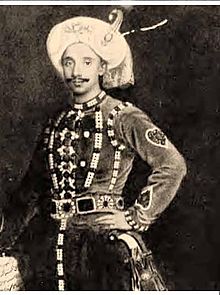Mansur Ali Khan
| Mansur Ali Khan | |||||
|---|---|---|---|---|---|
| Nawab Sayyid Mansur Ali Khan, Nawab Nazim of Bengal and Orissa | |||||
 |
|||||
| Reign | 29 October 1838 – 1 November 1880 | ||||
| Predecessor | Mubarak Ali Khan II of Bengal, | ||||
| Successor | Post abolished, succeeded by Nawab Sayyid Hassan Ali Mirza Khan Bahadur as Nawab of Murshidabad | ||||
| Born | 29 October 1830 | ||||
| Died | 4 November 1884 (aged 54) | ||||
| Wives |
|
||||
| Issue | 101 children, of whom 19 sons and 20 daughters survived him | ||||
|
|||||
| Dynasty | Najafi | ||||
| Religion | Shia Islam | ||||
| Full name | |
|---|---|
| Mansur Ali Khan |
Nawab Sayyid Mansur Ali Khan (29 October 1830 – 4 November 1884) was Nawab of Bengal until his abdication in 1880, whereupon he renounced his titles and position as Nawab of Bengal. Bengal had been under occupation of the British East India Company since 1773 when Warren Hastings was appointed by the East India Company as the first Governor-General of Bengal. By 1793 British East India company took complete control of Bengal (former Mughal province), making Mansur Khan just a titular ruler under the British Raj.
Nawab Nazim Mansur Ali Khan was born to Nawab Mubarak Ali Khan II and Rais-un-nisa Begum on October 29, 1830. He was only eight years old when he ascended his father Nawab Mubarak Ali Khan II on October 29, 1838, which happened to be the day of Eid ul-Fitr. He received the titles of Muntizam-ul-Mulk (Ruler of the Country), Mohsen ud-Daulah (Benefactor of the State), Feradun Jah (Of High Rank) and Nasrut jang (Helper in War). However, he was popularly known as Nawab Nazim Feradun Jah or Janab-e-Ali. Later, he was abdicated and received the lesser title of Nawab Bahadur and was denied the use of the qualification of His Highness.
After Mansur Ali Khan succeeded his father, Mubarak Ali Khan II on October 29, 1838 at the age of eight he became the Nawab of Bengal.
Mr. W.H. Elliot, appointed agent to the Governor General in December, 1838 relinquished charge of the Nizamat affairs in February, 1839 and the care of the boy Nawab passed into the hands of Colonel Caulfield. During the period from January 1840 to December 1846 there were many changes, three agents being appointed and relieved. The affairs of the Nawab's family were disordered and what disappointed them more was when Mr. Torrens appointed a lot of agents to the Governor General on December 17, 1846. The Nawab was unable to take part in the management of his affairs as he was very young and was surrounded by intriguers whose only idea was that of self-interest. Mr. Torrens was absent from April 1851 to December 1851, and he died on August 15, 1852. When the Nawab grew up he began to inquire into matters and found that there was confusion in all departments. The main things which were needed was the accounting of money and friendly cooperation between the native officials and the European agents and their officers. The government found it necessary to appropriate the certain so-called Nizamat Funds and made new arrangements with regards to the Nawab's stipend. But, the Nawab wanted full explanation and resented what, for want of full information, he regarded it as acts of injustice. The Nawab slowly started taking active interests in matters and found much to complain of, which made certain inquiries during the year 1852. Of ₹ 16 lacs assigned to him by the East India Company his personal allotment was ₹ 7,50,000 lacs only. The remainder was used for the other members of the family and any unexpected balance was transferred to the Nizamat Deposit Fund, which later became the subject of a great controversy.
...
Wikipedia
